Also with each of these types of flashing materials the top edge of the flashing is installed in such a way that it should never come in contact with the wood panel or sheathing.
Where to put flashing on a roof.
Install new flashing metal flashing is often called drip edge along the bottom of the roof near your gutters.
However the principles are the s.
Once even a small section of roofing cement fails you ll have a leak.
These leaks are almost always caused by improper flashing installation or the absence of roof flashing altogether.
Open valleys have metal flashing to protect this critical area of the roof.
Flashing can be purchased in pre formed styles to help you install it more easily and these include.
Recaulk the joints between the roof and the flashing.
How to install porch roof flashing.
Fasten loose nails and cover exposed nail heads with roofing cement.
Before running the first row of shingles install a piece of step flashing along the sidewall so that it sits tightly against the roof.
Align the step flashing with the leading edge of the starter course and nail it in place using one nail in the upper corner.
Each flashing job is a little bit different and depends on the type of material that the exterior of your house is made of.
Nail the drip edge in place using your hammer and roofing nails.
The purpose of roof flashing is to direct any water flow away from any intersections so when you install it keep this in mind to ensure that it can indeed do its job.
Renew flashing seals by chipping out old caulking and mortar along the edges of the flashing.
It may seem as if a single piece of flashing would offer more protection than many pieces of step flashing.
Install the step flashing.
The edge of the roof has thin metal flashing that helps water drip off the roof without damaging the home or causing a leak.
Roofing cement can dry out and crumble away exposing joints to water.
Continuous flashing against a sidewall is one way to install a roof but it s not the correct way.
Step flashing built to protect joints between roofs chimneys and other objects like skylights this flashing steps up above the shingles and attaches to the object providing comprehensive water protection.
Always install flashing around a chimney and other valleys where two roof planes meet as these areas are more prone to leaks if not protected.
But it doesn t work that way.
While some skylight manufacturers include flashing in their products sometimes roofing professionals have to create it or purchase it separately.





























